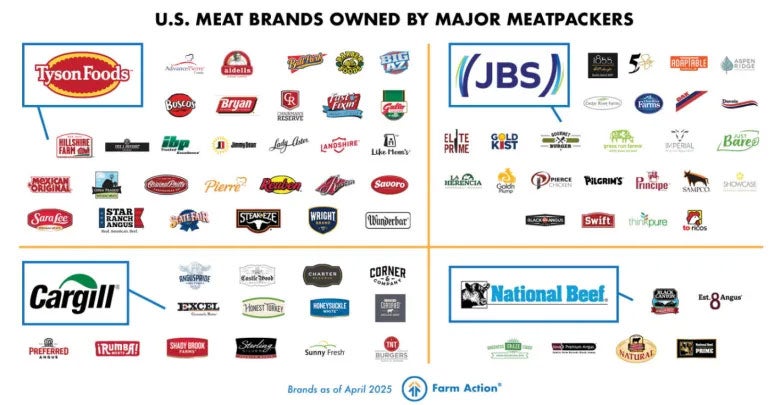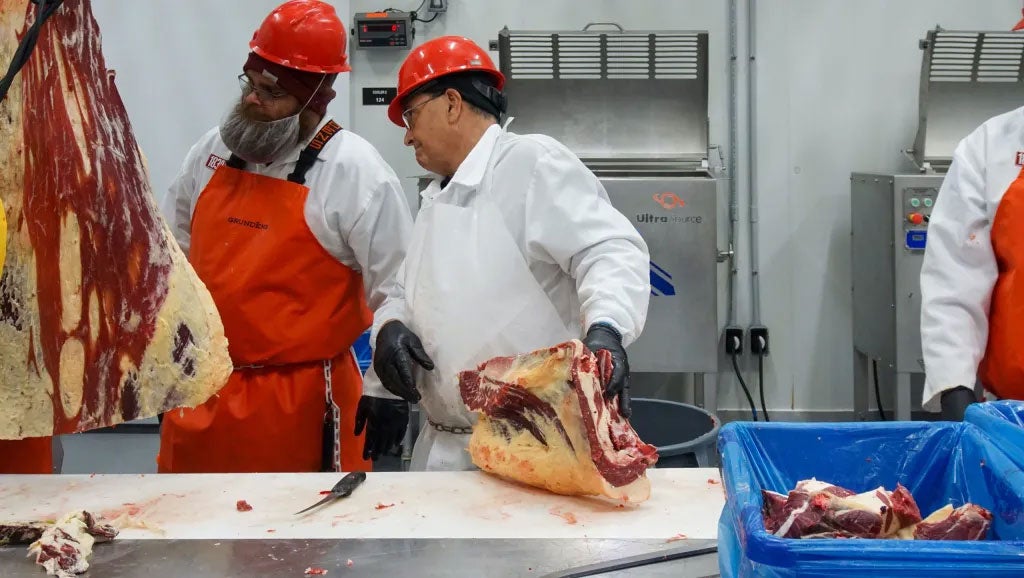This month, President Donald Trump directed the U.S. Department of Justice to investigate the nation’s largest meatpacking companies for potential collusion and price fixing.
“Action must be taken immediately to protect consumers, combat illegal monopolies and ensure these corporations are not criminally profiting at the expense of the American people,” Trump said in a social media post.
On Nov. 7, the White House published four claims in support of the investigation. Investigate Midwest fact-checked those claims.
Claim: The Trump administration stated, “The ‘Big Four’ meat packers — JBS (Brazil), Cargill, Tyson Foods, and National Beef — currently dominate 85 percent of the U.S. beef processing market, up from just 36 percent in 1980.”
True. These four companies (Marfrig owns National Beef) control roughly 85 percent of the U.S. beef industry, including owning more than 70 meat brands like Hillshire Farm, Swift, Honeysuckle and Jimmy Dean, according to data from the U.S. Department of Agriculture.

Claim: In calling for a DOJ investigation, the Trump administration said: “For too long, a handful of giant meat packers have squeezed America’s cattle producers, shrunk herds, and jacked up prices at the grocery store.”
Partly true. There is evidence that the consolidation of meatpackers has led to a decrease in the price ranchers are paid for their cattle.
However, a USDA study found that consolidation contributed to lower production costs, which in turn led to lower costs at the grocery store.
“Lower production costs did translate into lower consumer prices, increased consumption, and higher prices for cattle and hogs,” according to a 2024 USDA report. “However, with fewer rivals because of increased concentration, most of the studies found packers were also able to exercise some market power and pay lower prices for cattle than they would have had they faced more competitors.”
It is true that beef prices have increased for consumers in recent years, and the margin between cattle prices and retail prices has widened (indicating packer margins have grown). But many economic observers note that price increases at the grocery store have been mostly influenced by factors such as labor, transportation and input costs.
Claim: The Trump administration said, “Industry consolidation has crushed competition and hammered cattle producers.”
True. Since the 1970s, the nation’s cattle supply has become increasingly consolidated by larger meatpacking companies. An often cited USDA report from 2000 first highlighted the rate of “four-firm control,” or the measure of the beef industry’s outputs controlled by its four largest producers, which was 25 percent in 1971.
By 1992, the rate had jumped to 71 percent, and today it hovers around 85 percent.
Large plants across the country account for the majority of all slaughter. Just 12 federally inspected plants produced slightly less than half of the country’s beef supply as of 2022, according to an Investigate Midwest data analysis.
The nation’s cattle ranchers have faced increased consolidation in modern times, leaving them with few options when selling their herds to slaughter, often only able to accept a single large meatpacker as their buyer in their region.
Claim: Finally, the Trump administration claimed that the monopolization of the meatpacking industry has led to the exploitation of American consumers, farmers, and ranchers.” The administration went on to state: “In fact, mounting evidence shows this monopoly power has slashed payments to ranchers, reduced herd sizes, driven up consumer prices, and threatened America’s food supply chain.”
Partly true. American consumers have seen increased costs in numerous pantry staples in recent years. This increase can be attributed to rising inflation, COVID-19 supply chain disruptions, disease outbreaks and price-gouging.
Monopoly power in meatpacking isn’t the sole cause of the nation’s historic low cattle inventory. This low can also be attributed to climate-change-fueled droughts disrupting cattle feed and replacement cycles in the industry.
Consolidated power in the meat industry has disrupted the nation’s food supply in recent years.
A cyberattack on U.S. JBS plants in May 2021 resulted in ripple effects of delayed production. A 2019 fire at a Tyson slaughter plant in Kansas resulted in a 27 percent drop in cattle traded on the market during the following week, as the plant remained closed, according to a USDA incident report.
A disruption at these pivotal points in the food supply, no matter the cause, has a cascading effect on the entire food supply chain, from ranchers to consumers.
This article first appeared on Investigate Midwest and is republished here under a Creative Commons Attribution-NoDerivatives 4.0 International License.


